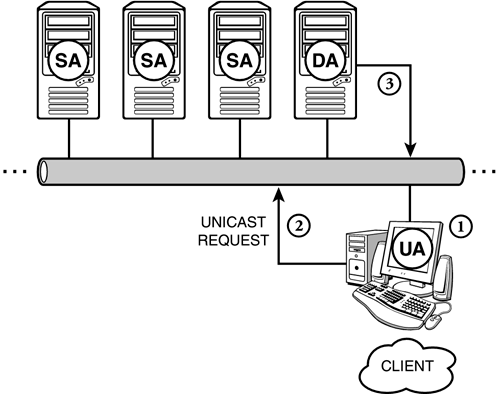SLPv2 Overview
| At its most fundamental level, SLP is an electronic GPS for network services. So how does it work? Services on the network register themselves with an SLP agent running on a NetWare server. When a client needs to locate a particular service on the network, it queries the SLP agent, which, in turn, provides the client with the address of the service. Furthermore, in NetWare 6, SLP works with eDirectory to help bring together the IP infrastructure services, such as eDirectory trees, DNS servers, NetWare servers, and various network protocol gateways. This enables clients to discover services by querying a central database rather than the whole network. In this SLP overview, we will begin by exploring the family of Name Service Providers supported by NetWare 6. Then we will focus on SLP as the preferred provider and dive into more detail regarding its architecture. Finally, we will discover Directory Agents, User Agents, and Server Agents, and learn how they communicate with each other to provide network services to NetWare 6 clients. NetWare 6 Name Service ProvidersSLP is not the only Name Service Provider supported by NetWare 6. In fact, five different providers deliver name resolution services to Novell clients. Following is a brief description of SLP's Name Service Provider family:
NetWare 6 uses SLPv2. As we learned earlier, SLPv2 offers numerous enhancements over the SLPv1 version used in previous releases of NetWare. Table 4.7 is a short list of the network services autodiscovered by SLPv2. In summary, SLPv2 provides two primary benefits to NetWare 6 networks: management and fault tolerance. SLPv2 centralizes network management by autoregistering changes in network architecture whenever a workstation or protocol is reconfigured. In addition, SLPv2 enhances fault tolerance because it enables clients to find services regardless of whether they are running on primary or secondary servers.
SLPv2 ArchitectureSLP employs a relatively "flat" architecture. At its most basic level, SLP clients and servers communicate directly with each other and pass name resolution and service availability data. With eDirectory integration, SLP can use the power of a centralized Directory Agent to provide central distribution of network services and to improve bandwidth utilization on large, enterprise networks. SLP uses three software agents to store information about services available on your TCP/IP network:
As we learned earlier in this section, SLP works best when it is integrated with eDirectory. Furthermore, the flat architecture described earlier is inadequate for scalability and traffic management in large networks. Fortunately, SLP does support certain levels of hierarchy. This support is accomplished by organizing SLP services into groups called scopes. The cool thing about SLP scopes is that they are integrated into eDirectory as manageable objects, and also then viewable in ConsoleOne. Creating these groups of services speeds up the access to requested services while reducing the number of packets on the wire. For example, some services may be regularly registered on machines in ACME's NORAD department and have no use to anyone outside that location. Thus, you could configure the DA on a server in the NORAD department with a specific scope for that container only. Then clients in the NORAD location will be configured with the IP address of the DA for that area. SLPv1 and SLPv2 scopes are basically the same. However, they differ in one very significant way:
The DEFAULT scope has no special properties and can be renamed according to the naming standards of the organization. There is one important caveat, however in SLPv2, DAs, SAs, and UAs cannot communicate with SLPv1 UNSCOPED scopes. Fortunately, the Novell implementation makes SLPv2 compatible with SLPv1 by ensuring that DAs, SAs, and UAs can all communicate with v1 and v2 scopes. The only requirement is that all SLPv1 scopes be given a name. So how do SLPv2 DAs, UAs, and SAs communicate with each other? Let's take a closer look.
SLPv2 CommunicationsSLP is basically a communication protocol in which DAs, UAs, and SAs communicate with each other to identify and locate available services on the network. However, the method of communication between these SLP Agents differs dramatically with small or large networks. Let's take a quick look at how SLPv2 communicates at both ends of the network spectrum. Small Network: SLPv2 Communication Without a Directory AgentA small network with fewer than 25 servers gains negligible advantage from an SLP DA. In this scenario, all SLP communication can be handled by the SAs and UAs with local segment IP multicast. Without a central DA, NetWare 6 Services register themselves with the SA running on their host server. Therefore, the SA knows about the services and can respond to specific client's requests. Following is a step-by-step description of how SLPv2 communication operates in a small network (follow along in Figure 4.22):
Figure 4.22. SLPv2 communications without a Directory Agent.
Large Networks: SLPv2 Communications with a Directory AgentIn a large network, SLP requires DAs to provide scaling and remote connectivity support. If the network is architected to be a rather flat system, then a single DA may be sufficient. Unlike the smaller networks, there is little IP multicast in this architecture. Furthermore, DHCP can be used to configure each client UA with the IP address of the Directory Agent. This way DA information can be stored in eDirectory and replicated throughout the global network. Following is the flow of SLPv2 communications with a Directory Agent (follow along with Figure 4.23):
Figure 4.23. SLPv2 communications with a Directory Agent.
In this section, we discovered a lot about Name Service Providers, SLPv2 architecture, and communications with or without Directory Agents. Now we will venture off the easy path into a much more sophisticated configuration lesson. Next, you will learn how to configure SLPv2 DAs, SAs, and UAs with NetWare 6's new and exciting Web management tool iManager. And while you're at it, don't forget our new NetWare 6 motto: "iManage, therefore I am." |
EAN: 2147483647
Pages: 128

